Making a Crisis Communication Plan (+ Crisis Communication Templates)
In today’s complex and interconnected professional world, there is an unlimited number of internal and external factors impacting the operations of every organization. In such a complex environment, a potential crisis is never too far around the corner.
While we can rarely predict a crisis, we can certainly prepare for it. In this article, we will examine the anatomy of a comprehensive crisis communication plan. We will also provide ready-made, industry-specific crisis communication plan templates to help you better prepare for any eventuality.
Quick access to crisis communication plan templates:
⏬ General crisis communication plan template
⏬ School crisis communication plan template
⏬ University crisis communication plan template
⏬ Business crisis communication plan template
⏬ Technology crisis communication plan template
⏬ Hospitality industry crisis communication plan template
⏬ Non-profit crisis communication plan template
⏬ Hospital crisis communication plan template
⏬ Sports crisis communication plan template
⏬ Transport & logistics crisis communication plan template
⏬ Agriculture crisis communication plan template

Table of Contents
What is crisis communication?
Crises represent unpredictable events perceived to threaten an organization’s performance, jeopardize stakeholder expectations, and create negative outcomes.
According to one definition, crisis communication is “the collection, processing, and dissemination of information required to address a crisis situation.” In other words, it is the totality of messages an organization broadcasts to respond to a crisis.
Crisis communication can take place internally within the organization, and externally, towards different groups of stakeholders and the general public.
Both internal and external crisis communication are equally important.
External communication protects the reputation of the organization in the eyes of its stakeholders and the public
Internal communication can enable and motivate employees and other members of an organization to perform through times of crisis.
🎓 Pumble Pro Tip
If you’d like to learn what are the guiding principles of effective internal crisis communication, read our guide:
What is a crisis communication plan?
Crisis communication in itself does not require a plan — representatives of a crisis-stricken organization will be required to communicate whether they are prepared for it or not.
However, many managers have tried winging it and an overwhelming body of empirical proof strongly suggests that it is a bad idea.
Just ask Tony Hayward, the former CEO of British Petroleum and the principal actor of what became known as the worst PR disaster in history.
A crisis communication plan is a set of guidelines, information, and resources that represent a blueprint for a fast and effective response to an emerging crisis.
It includes communication steps and operational processes that span the duration of a crisis, from identifying what’s taking place all the way to post-crisis assessment.
It gathers all relevant information in one place and helps organizations formulate and communicate a cohesive and consistent set of messages that will help overcome a crisis — or at least not make a bad situation even worse.
How to make a crisis communication plan?
Crisis communication plans can come in many shapes and sizes. They can be bare-bones or extremely detailed and can include or exclude certain sets of information.
Regardless of their format or their scope, any comprehensive crisis communication plan should span the following areas:
- Defining the goal
- Defining team roles and personnel
- Identifying key stakeholders
- Identifying risks and potential crisis scenarios
- Alert mechanisms
- Information gathering
- Information distribution
- Employee guidelines (including social media)
- Post-crisis assessment
Let’s see what each of these areas represents and involves.
Defining the goal
Don’t worry, in the context of a crisis communication plan, defining the goal isn’t a vague, abstract mission statement, but a very practical definition of the document’s scope.
This includes defining its purpose and its communication objectives.
For instance, the plan can be intended solely for internal crisis communication, solely for the media, the general public, specific groups of stakeholders, or all of the above. Understanding the scope, the purpose, and the objectives of crisis communication enables us to devise the right approach.
Defining team roles and personnel
Having a dedicated crisis response team with clearly defined roles and responsibilities is a strong platform for effective crisis management.
A crisis response team is supposed to organize and coordinate a variety of tasks related to four main areas of activities:
- Gathering information
- Decision-making
- Formulating messages
- Communicating messages
The make-up of a response team will greatly be determined by the specifics of an organization’s work.
However, the general distribution of key roles remains fairly universal, including:
- designated internal and external spokespersons
- experts and knowledge holders in relevant areas
- upper management representatives with decision-making powers
- A necessary number of coordinators and technical personnel for operational matters
Identifying key stakeholders
Stakeholders are individuals and groups without whose support organizations would cease to exist.
Based on the degree of involvement in the organization, stakeholders can be:
- primary (employees, customers, stockholders, suppliers, etc.), and
- secondary (general public, the media, activist groups).
Identifying and prioritizing key stakeholders allows us to better understand our key communication objectives and target audiences and address them accordingly.
Identifying risks and potential crisis scenarios
While it is often very difficult to exactly predict the timing and the nature of a crisis, we can still prepare for the likelier eventualities.
The first step in this process is assessing the operations and identifying any visible weaknesses and areas at a greater risk of disruptions and instability.
Once we identify any risk areas, we can proceed to formulate related crisis scenarios and prepare the processes and the messaging for a response.
Alert mechanisms
This area refers to the internal activities at the first notice of an emerging crisis.
Specifically, it defines what takes place once a crisis is detected: who needs to get notified, what mechanisms are triggered, and what are the necessary steps to get the response team up and running as quickly as possible.
Information gathering
Before the response team can formulate its messages, it must gather all available information on what has taken place and what steps are being taken to manage the crisis. For this, it is crucial to identify key information holders in different areas of the organization and either have them included in the response team or readily available for consultation.
The response team will need to continue to gather reliable information and base its messaging on it through the duration of a crisis. Many crisis communication plans include a fact sheet — a list of all available verified information about a crisis. This helps ensure that the members of the response team (as well as any other involved parties) have the same information and align over its interpretation.
Information distribution
This area is the act of communicating itself.
A crisis communication plan needs to answer the following key questions:
- What needs to be communicated?
- Who communicates it?
- When do they communicate it?
- Through which channels?
Information distribution spans everything from emergency alert systems to media relations, including internal communication.
A solid plan will define and detail all relevant channels of communication, all individuals and groups that need to be reached through those channels, and those responsible for reaching them.
🎓 Pumble Pro Tip
Information distribution grows even more complex in a remote setting. To master keeping everyone in the loop remotely, read our guide:
Employee guidelines
Once a crisis escalates, it is difficult to keep the surrounding conversation under control, particularly in today’s world of social media and other individual platforms. Organizations need to define how they expect their members to handle work-related communication on their personal channels in crisis situations and provide clear actionable guidelines.
While each organization will define its policies as it best sees fit, experience has shown that rather than attempting to censor or silence employee voices, it is better to embrace social media and provide them with reliable information and guidance and enable them to best represent the organization.
Post-crisis evaluation
The work of the response team does not end with the de-escalation of a crisis. Post-crisis evaluation of the organization’s response enables us to better prepare for the future.
The response team needs to properly assess the quality of the response, take note of the practices that have yielded positive results, as well as any weaknesses in the plan. Any recognized weaknesses need to be addressed in the plan for any future situations.
The evaluation can be conducted by the members of the response team or a broader group of internal stakeholders.
Crisis communication plan templates
In order to get you up and running on writing your own crisis communication plan, we have prepared several helpful templates, both a universal, all-purpose template, as well as a number of templates modified to suit specific industries.
How to use the templates
Every organization is unique, as are its specific operational circumstances.
The templates provided below are intended as a starting point, and not the end product.
They will help you understand the requirements of a comprehensive crisis communication plan. Of course, organizations are free to exclude any sections they deem irrelevant and expand the plan for any organization-specific or industry-specific information, mechanisms, or guidelines.
The templates we have prepared to get you up and running with your crisis communication preparation are:
- General crisis communication template
- School crisis communication template
- University crisis communication template
- Business crisis communication template
- Technology crisis communication template
- Hospitality industry crisis communication template
- Non-profit crisis communication template
- Hospital crisis communication template
- Sports crisis communication template
- Transport & logistics crisis communication template
- Agriculture crisis communication template
General crisis communication plan template
Start formulating your own crisis communication plan with a universal and comprehensive template suitable for all organizations, regardless of their size or profession.
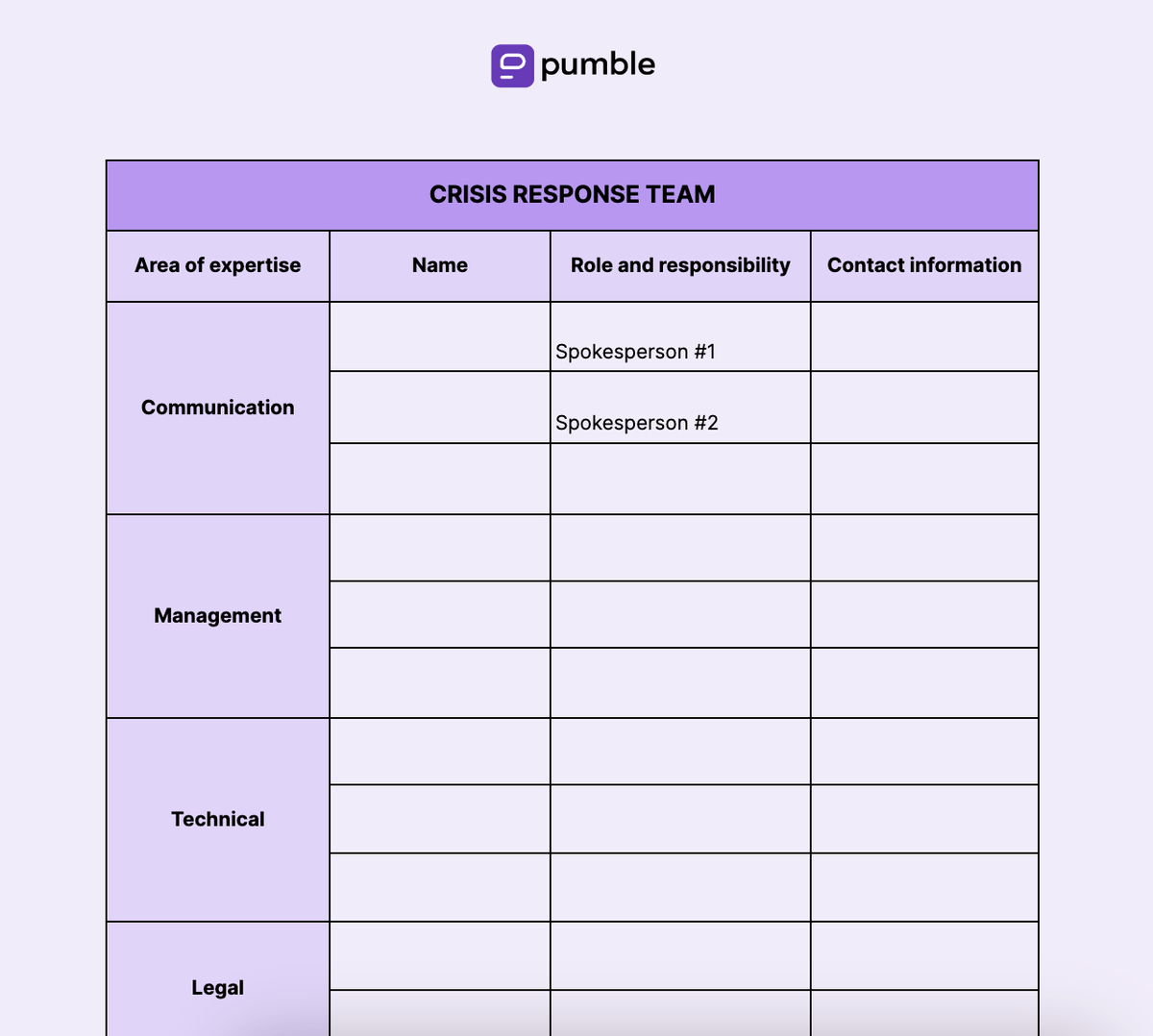
School crisis communication plan template
Understand the potential risks of school settings and start formulating your response with a crisis communication plan template tailored to the educational environment.
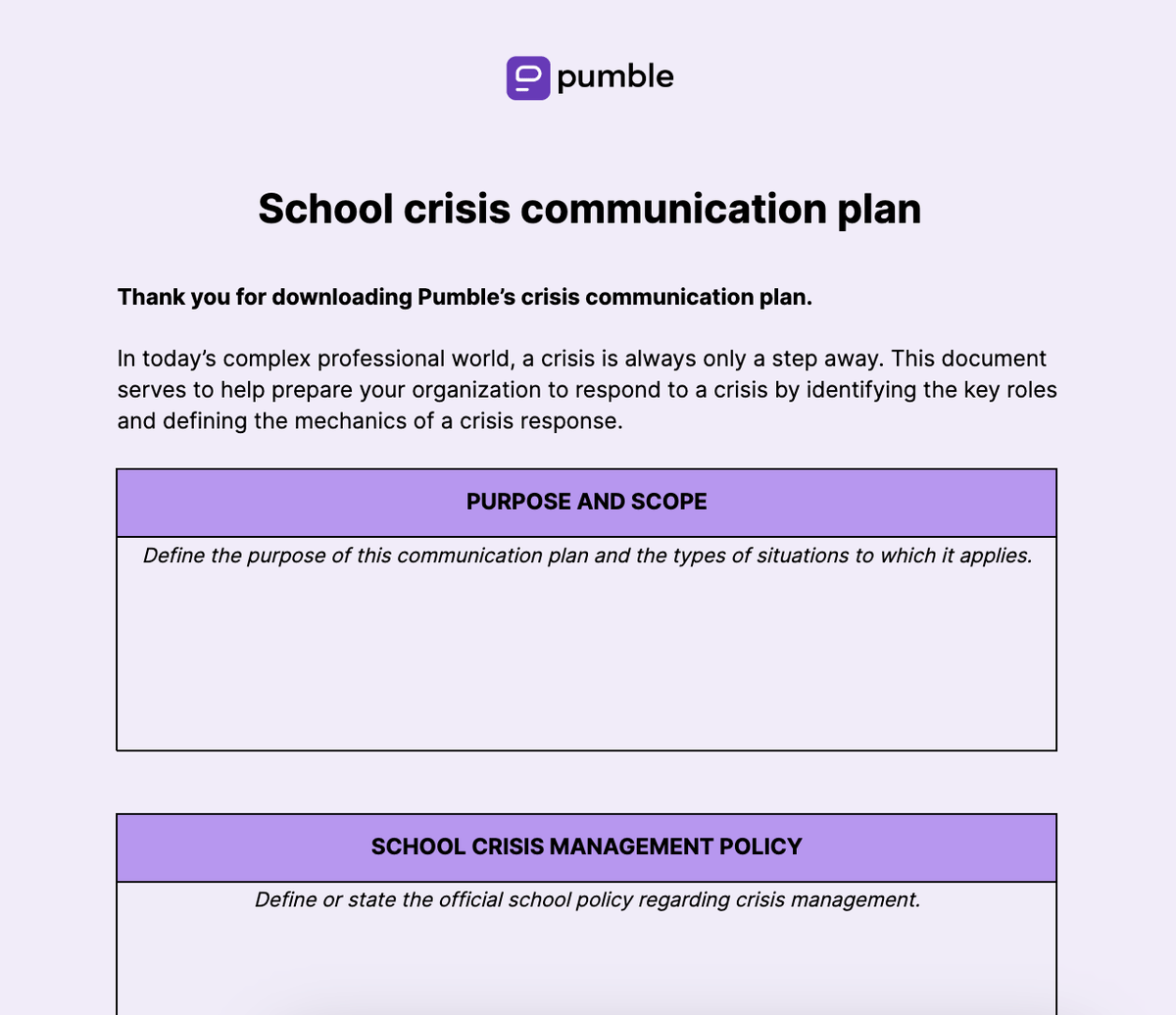
University crisis communication plan template
Stay on top of all common crisis scenarios in higher education with a university-focused crisis communication plan template.
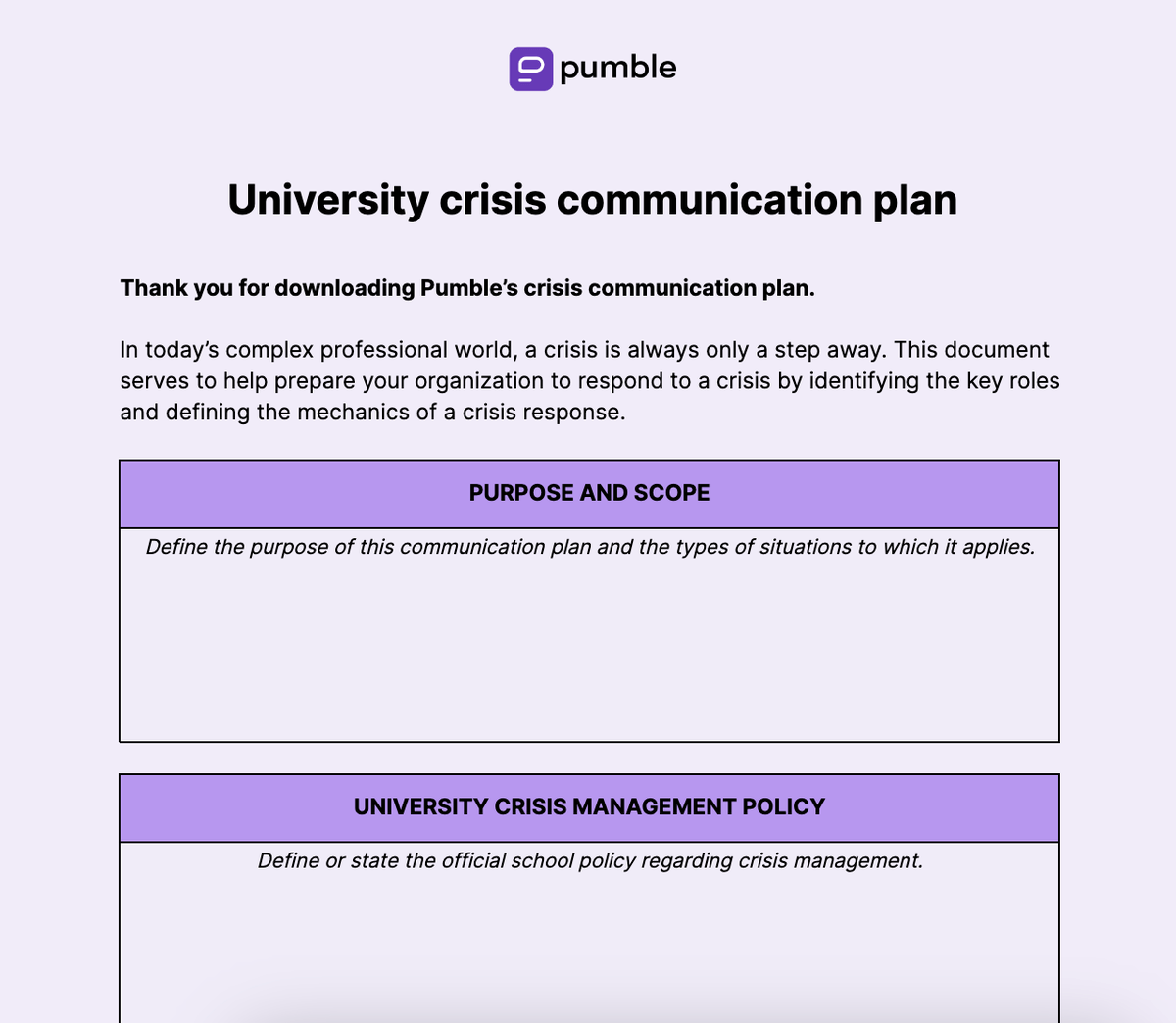
Business crisis communication plan template
The volatile world of business is never too far removed from the next crisis. Prepare for what’s to come with this template specifically designed for the business ecosystem.
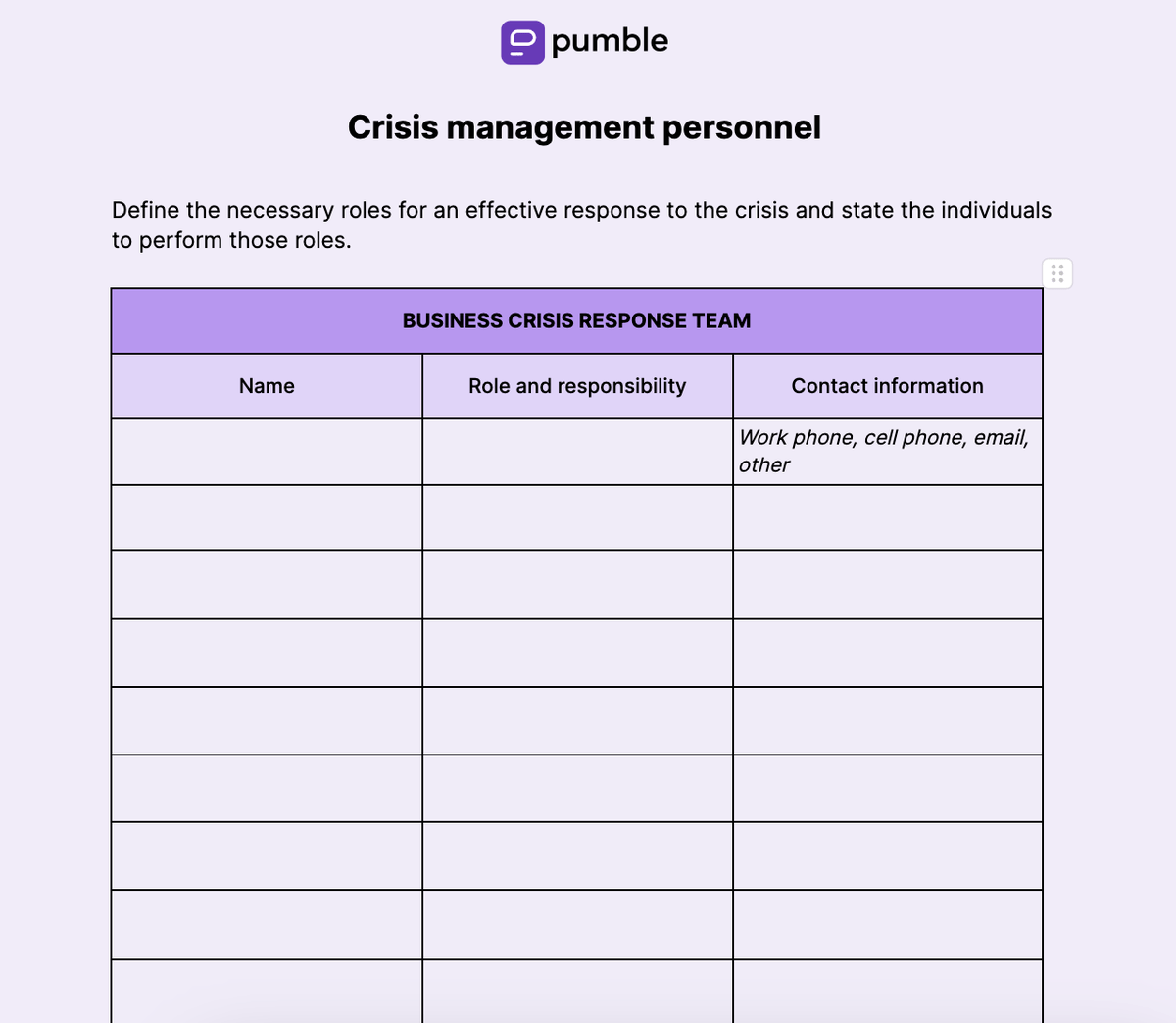
Technology crisis communication plan template
The increasingly complex world of technology is susceptible to all sorts of disruptions. Stay ahead of the game by planning and preparing for the next inevitable crisis.

Hospitality industry crisis communication plan template
From dissatisfied customers to disease outbreaks, the hospitality industry has been fertile ground for a variety of crises. Sort out your communication ahead of the next one.
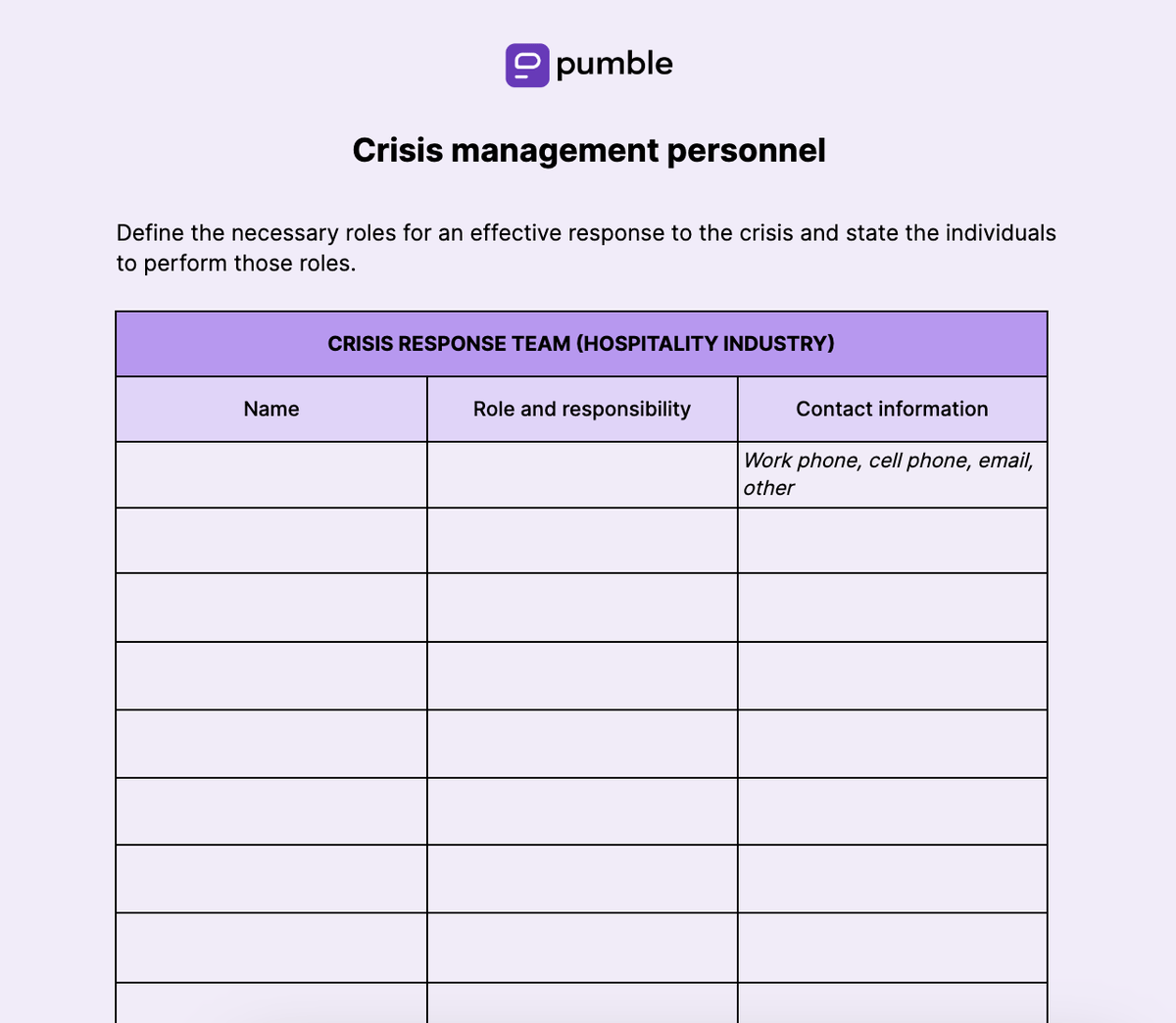
Non-profit crisis communication plan template
The non-profit sector has seen its share of crises and disruptions, requiring organizations to plan for future turbulence. Stay vigilant and prepared for any eventuality.
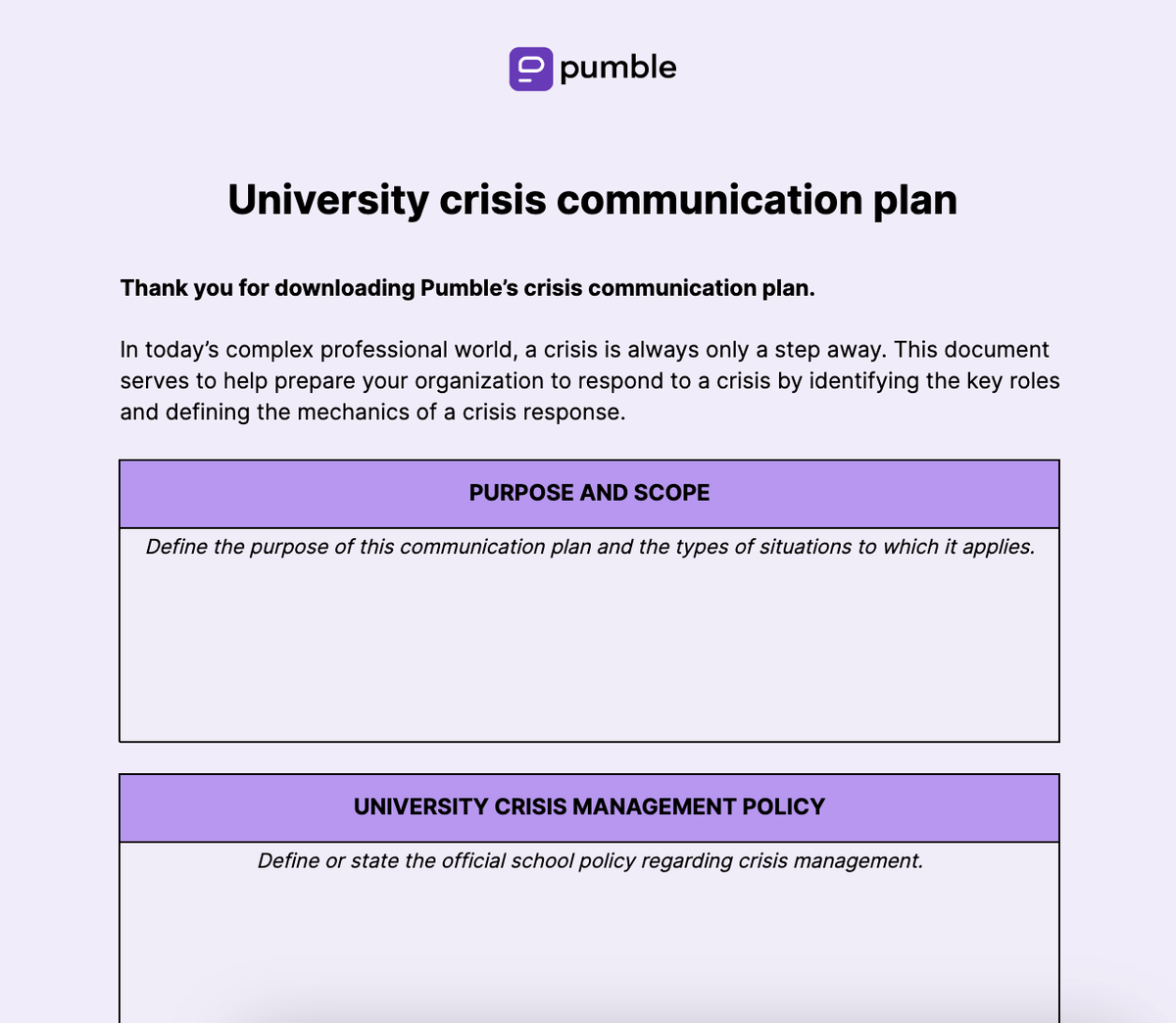
Hospital crisis communication plan template
In health care, crises are business as usual. Prepare to drive and shape the conversation to navigate the slippery slopes of crisis communication.
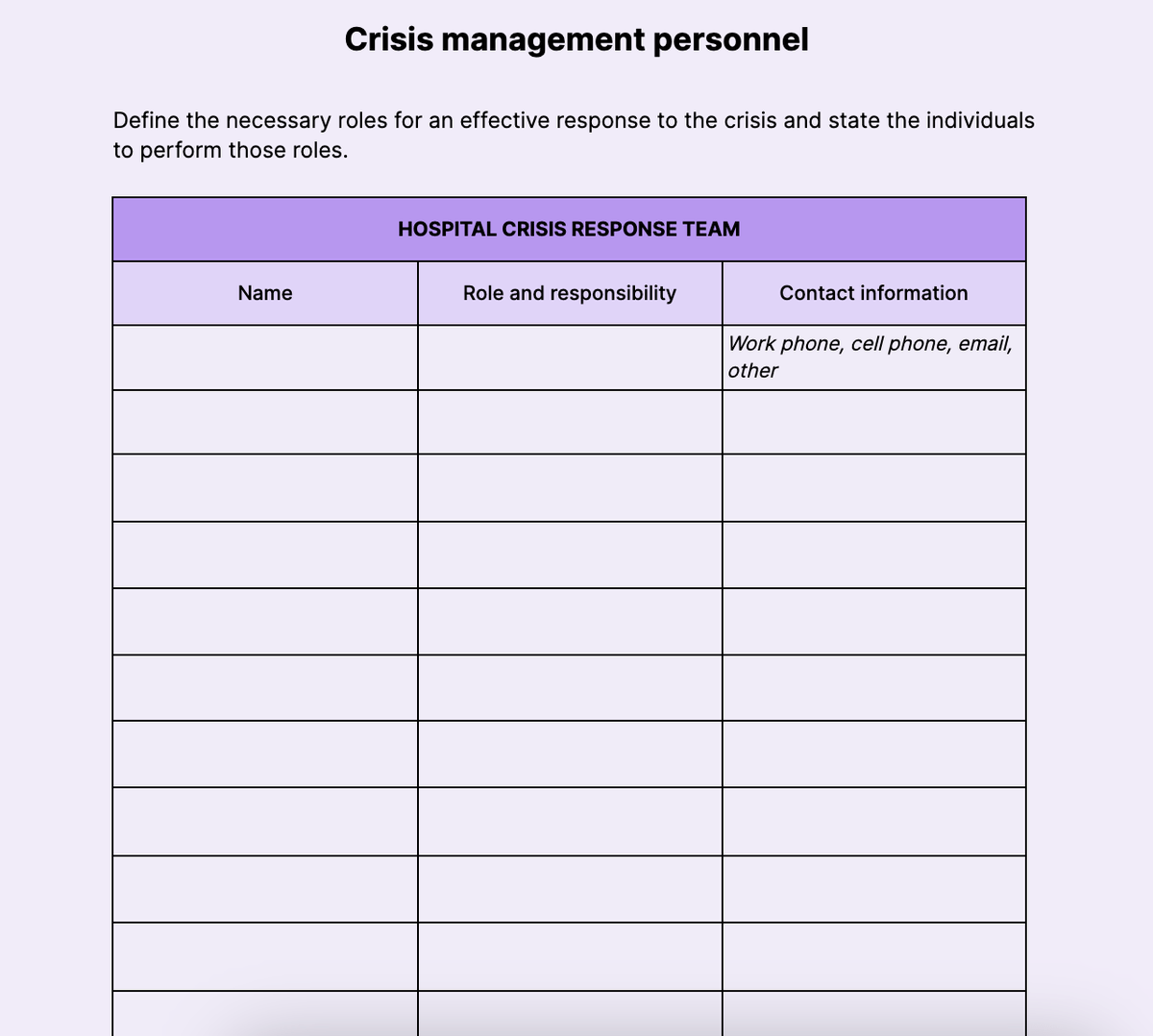
Sports crisis communication plan template
Egos, entitlement, disgruntled fans, financial “creativity” — the world of sports is a constant crisis in the making. Grab hold of any crisis situation by communicating proactively.
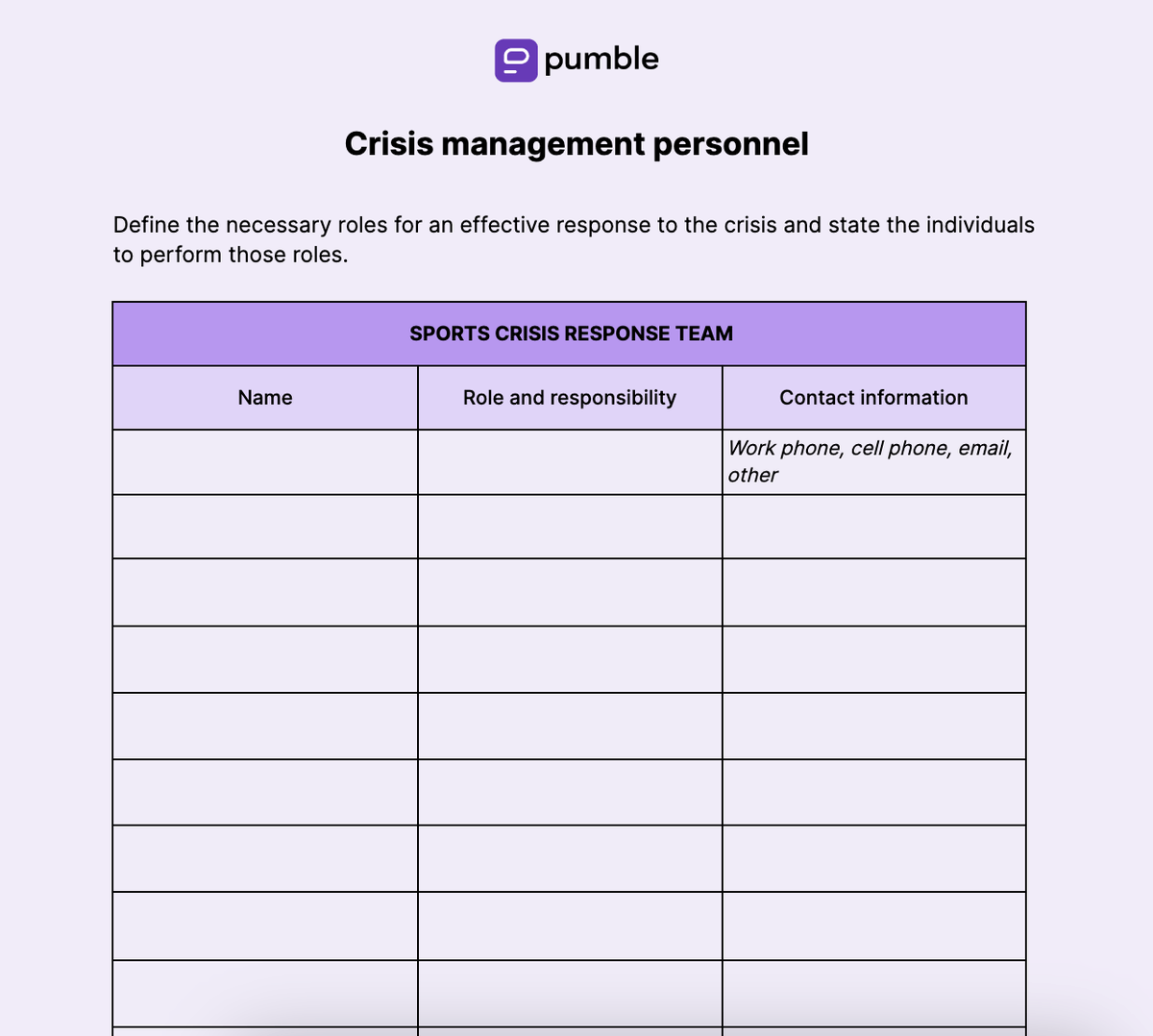
Transport & logistics crisis communication plan template
Transport & logistics are a complex web of interconnected moving parts. Derail one part and you easily derail the whole. The next crisis is right around the corner — be prepared to respond!
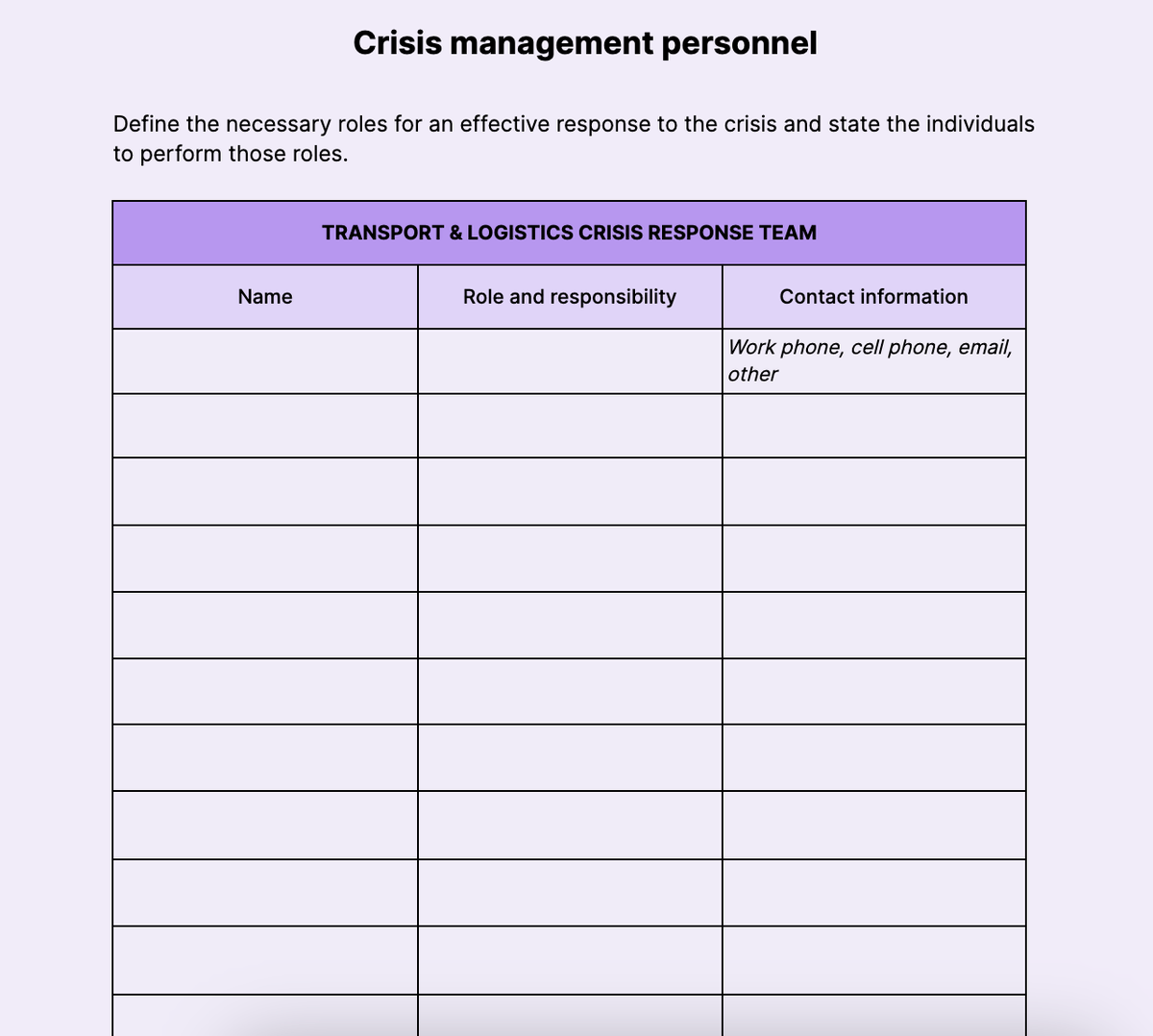
Agriculture crisis communication plan template
Food, air, and water are the building blocks of human life. Every disruption can quickly become a full-blown crisis. Enable your organization to manage the surrounding conversation to your advantage.
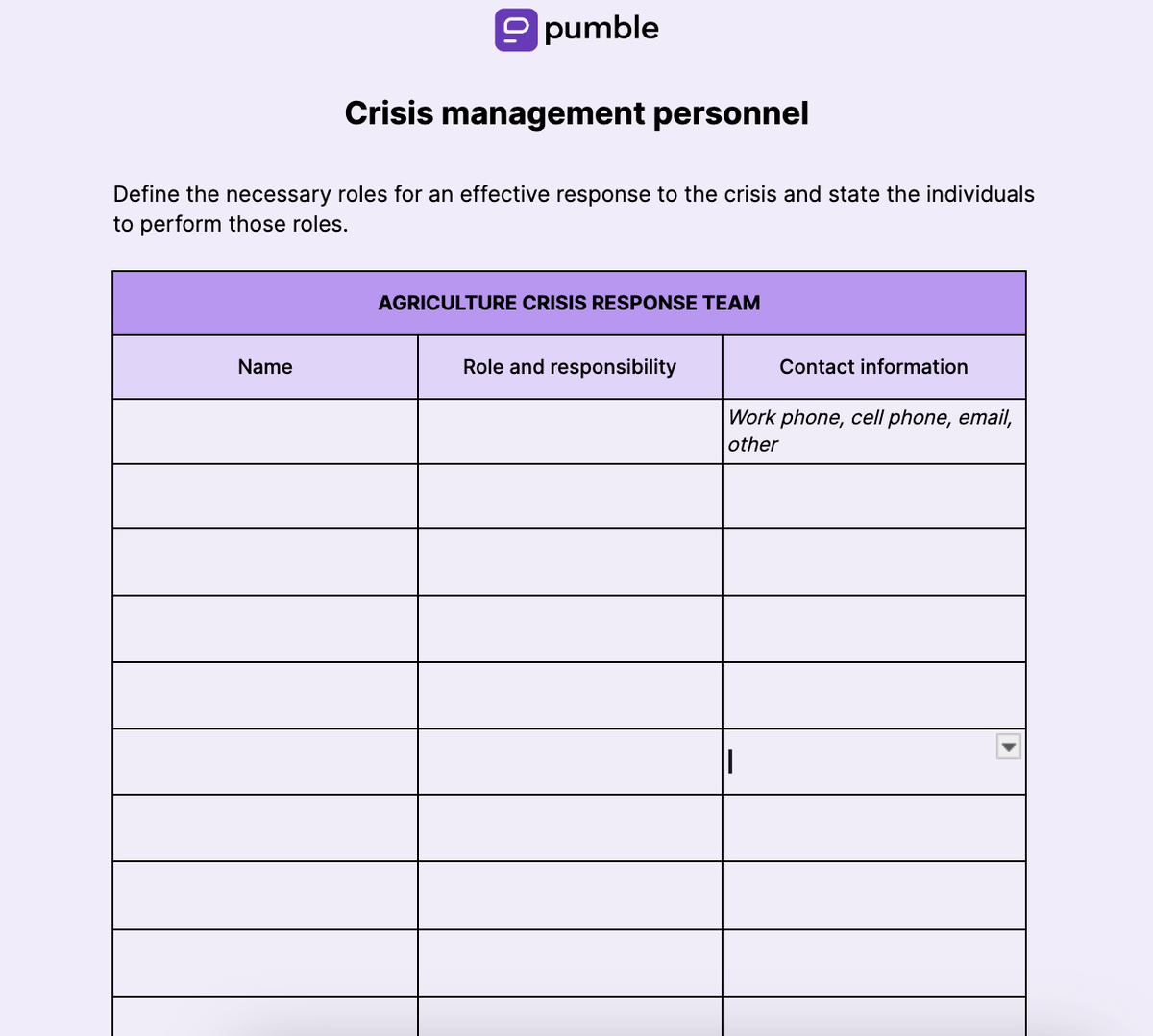
Prepare for the unexpected future with Pumble
Crisis communication often deals with unexpected and unpredictable situations. A crisis communication plan enables you to respond to surprises with organization and decisiveness. Having pre-defined actors, roles, and mechanisms in place for times of crisis will ensure a coordinated, timely, and efficient response.
Furthermore, some crises can even be prevented or minimized through regular and efficient communication between team members.
Pumble, a business messaging app, enables and encourages active team communication. It allows teams to arrange and maintain all their conversations in a structured whole that promotes collaboration and interaction without sacrificing organization and efficiency.
Take advantage of its:
- Direct messages for immediate updates,
- Channel organization for streamlined communication, and
- Robust notification preferences to ensure messages are seen promptly.
As you prepare and confront the challenges of crisis communication, Pumble can serve as a valuable tool for enhancing your response strategies.
 Team Communication Hub
Team Communication Hub 








